Warhammer 40000 mechanicus гайд
Обновлено: 05.07.2024
Наверняка у многих была мысль: "Хочу вкатиться в Ваху, но наверное это сложно. ".
Почти год назад (в апреле) я решил, что раз я уже взрослый (как никак тридцатник), то пора начать собирать солдатиков по вахе. Мечта детства, так сказать.
Мне нравится вселенная, мне нравится сеттинг, а из-за того, что в виртуальном мире по Вахе выходит крайне мало интересных и стоящих проектов, решение начать настолку было принято довольно быстро.
Конечно этому решению поспособствовало то, что я все больше стал погружаться в мир настольных игр: Codex, Warhammer 40000: Conquest, Arkham Horrors (LCG который, всем советую); уже даже подумываю над DnD.
Что вообще входит в настолку?
В принципе данное хобби можно разделить на 2 существенные части: коллекционирование моделей и сама игра (правила, геймплей).
Для начала выбираете себе фракцию по вкусу. Фракций в Вахе, как известно, много, они разные, со своими особенностями, недостатками и преимуществами.
Тут вы найдете все стандартные фракции Вахи:
•Империум
•Хаос
•Орки
•Эльдары
•Тираниды
•Некроны
•Тау
Кроме того, у каждой фракции есть разные армии. К примеру в Империум входят космические морячки, гвардия (которая теперь называется Astra Militarum), механикусы (-кумы, кому как нравится).
У эльдар можно выделить 3 армии: Дракхари (или темные эльдары), Аэльдари (обычные эльдары) и арлекины.
В общем с большой вероятностью вы найдете армию себе по вкусу. Модельный ряд и особенности каждой армии описаны в так называемых Кодексах:


Такие кодексы есть как в печатном виде, так и в электронном. Но о самих кодексах чуть позже.
Для удобства «вхождения» в хобби, GW делает разные стартовые наборы. Одни наборы могут содержать 2 почти полноценные армии:

Другие наборы сфокусированы на конкретной армии:

Практически для всех армий существуют такие Start Collecting, но если вы такой не нашли — не беда. В магазине вам всегда подскажут, что лучше купить для старта.
Внутри таких коробок, вас ожидают литники. Литниками называют вот такие пластиковые держатели, на которых находятся детали моделей:

Вариативность сборки моделей присутствует. Во-первых позы вы можете выставлять сами (конечно рамки есть, но все равно можно сделать разнообразные позы). Во-вторых в наборах очень часто идет множество не обязательных деталей: всякие фляги, ножи, разные головы, ноги, вооружение и т.д.
Собираем и красим
Сами модели представляют собой качественный пластик, который легко клеется специальным клеем для пластика (по сути клей работает как растворитель и сплавляет 2 части). После сборки и перед покраской, модели требуется загрунтовать. Это нужно для того, чтобы после наложения акриловых красок они не отслаивались от модели. Самая часто используемая грунтовка это черная в виде спрея. Вот такой балончик с краской:

На ютубе можете найти кучу гайдов по тому, как правильно накладывать грунт, но в целом правило простое: встряхиваете балончик минуты 2-3 и короткими залпами с расстояния в 20-30 см брызгаете краской на модель с разных сторон. На каждую сторону по 1-2 нажатия.
После, грунтовка сохнет 1,5-2 часа. Получаем такой вот результат:

Теперь можно приступать к покрасу.
Для покраса вам потребуются акриловые краски. Обычно, в магазине, где вы покупали миниатюры будут и краски. Могут быть как фирмы Vallejo, так и классические краски Citadel:


Стоит учитывать, что цветовые схемы, указанные на сайте GW используют названия красок Citadel, но за 1 минуту в гугле вы найдете аналоги этих цветов и у других производителей.
Ну, а дальше вы берете в руку кисточку и начинаете красить свои модельки!
Это на самом деле не сложно, и даже такой криворукий человек, как я, смог сделать такое:
Серьезно, это мои первые модельки! Все, что я сделал, это аккуратно следовал гайдам. На каждую модельку уходит от 2 до 8 часов (ну к примеру на танк у меня ушло 8 часов).
Пока мой уровень не позволяет мне эксперементировать со своими цветовыми схемами (на самом деле я просто не пробовал), но в целом таких результатов я достиг менее, чем за пол года. Красил по 1-2 модельки в день.
Включаете любимого стримера (сериал, фильм, аниме (ладно, ладно, тут я пошутил) или музыку) на фоне и творите!

Правила и геймплей
Играть в ваху можно хоть крышками от газировки (но все же лучше собрать модели).
Если у вас хорошо с английским, можете прочитать вот этот талмут на 280 глянцевых страниц.

На самом деле сами правила начинаются на 170-ой странице и занимают не так много, как кажется. Остальное это приятное наполнение в виде ЛОРа, описания фракций и т.д.
Но даже оставшиеся страницы с правилами могут показаться сложными. Это не так, и я опишу основное ядро.
В вахе используется система отрядов. Т.е. у вас есть юнит, который состоит из 1 или более моделей. К примеру юнит примарх Робаут Жиллиман это юнит состоящий из 1 модели (собственно его самого), а юнит пехоты гвардейцев состоит из 10 моделей. Разные правила игры могут касаться всего юнита или конкретных моделей.
У всех юнитов есть datasheet. Это профиль юнита, который описывает его характеристики и способности:

Параметры:
M — показатель движения. На сколько дюймов (все измерения дистанции в Вахе происходят в дюймах) может передвинуться модель в юните
WS — weapon skill — параметр, отвечающий за умение драться в ближнем бою. 4+ означает, что модель в юните будет попадать в ближнем бою при выпадении на кубике результата 4, 5 или 6. Если при проверке на «попасть» выпало 1, 2 или 3 — модель не попала
BS — ballistic skill — параметр отвечающий за умение стрелять. Работает ровно так же, как и WS.
S — strength — сила. Параметр отвечающий насколько силен персонаж. Чаще всего этот параметр будет использоваться в ближнем бою.
T — toughness — выносливость/прочность. Данный параметр отвечает насколько прочна модель, как хорошо она переносит ранения/повреждения.
W — wound — раны. В простонародье это просто ХП модели.
A — attack — атака. Параметр отвечает за количество атак в ближнем бою. Если значение 1, то модель может совершить только 1 атаку в ближнем бою.
Ld — leadership — показатель лидерства. Используется в основном при провекре, выдержали ли нервы у юнита из-за потерь или нет.
Sv — save — спасбросок. Данный параметр отражает насколько хороша броня у модели. Работает по аналогии с WS и BS. Т.е. когда надо совершить спасбрасок, вы бросаете кубик и смотрите на результат. Если результат равен или выше значения данного параметра, то спасбросок считается успешным и модель не получит урона.
В дополнении к параметрам модели, есть параметры оружия:
S — сила оружия. Если это стрелковое оружие, то обычно у него своя собственная сила. Ну к примеру у лазгана сила 3. Если это оружие ближнего боя, то обычно используется сила user, т.е. сила модели, которая использует это оружие.
AP — armor penetration — пробивание брони. Данный параметр является отрицательным модификатором к Sv цели, по которой стреляет/бьет ваша модель. Как конкретно это работает будет далее.
D — damage — урон. Если вы успешно нанесли урон данным оружием, то столько урона полчит враг (очевидно, капитан!).
И так. Игра состоит из 6-ти основных фаз:
1. Movement phase (фаза движения)
2. Psychic phase(психофаза, фаза когда можно использовать заклинания)
3. Shooting phase (фаза стрельбы)
4. Charge phsae (фаза «штурма»)
5. Fight phase (фаза рукопашки)
6. Morale phase (фаза морали)
Игрок в свой ход полностью проходит все фазы, после чего передает ход другому игроку, который в свою очередь тоже проходит все фазы. Полный цикл (когда оба игрока завершили свой ход) называется battle round.
Назначения большинства фаз очевидно из названия. В фазу движения мы перемещаем свои войска по полю боя.
В психофазу мы используем заклинания (если у нас есть юниты, которые могут колдовать).
В фазу стрельбы наши войска, внезапно, стреляют.
В charge фазу (не могу придумать адекватный перевод, да он и не нужен), если ваш юнит находится в <12" (дюймы) от вражеского юнита, то он может объявить в него чардж. Вы кидаете 2д6 (2 обычных шестигранных кубика), полученный результат это количество дюймов, на которые может передвинуться ваш юнит. Если этого значения достаточно, то ваш чардж успешен и вы можете передвинуть модели в юните на данное значение. Если чардж меньше, чем расстояние до врага, то чардж не успешный и ваш юнит не двигается.
В фазу рукопашной дерутся юниты, которые находятся в 1" от вражеского юнита (вражеский юнит после этого бьет в ответ).
В фазу морали идет проверка на… мораль! Если за текущий ход юнит пехоты гвардейцев из 10-ти моделей потерял 5 моделей, то владелец юнита будет кидать д6. Полученный результат складывается с количеством потерь. И если конечное значение больше, чем значения Ld юнита, то РАЗНИЦА между этими значениями и есть то количество моделей, которые сбежали с поля боя.
Звучит сложно? Да, немного. Но на примере будет нагляднее.
У нас есть вышеуказанный юнит пехоты из 10-ти моделей (для простоты примера, в отряде не будет сержанта). Данный юнит за ход потерял 5 моделей. Владелец юнита кидает кубик и выпадает 4. Конечный результат получается 9, в то время как Ld юнита составляет 6. Вычитаем 6-9=-3. Если значение отрицательное, то убегает ровно такое количество моделей (т.е. 3 модели). Убежавшие модели просто убираются со стола, как убитые.
Механика попаданий и нанесение урона
Осталось рассказать часть, про попадания и нанесения урона.
Тут тоже не rocket science.
Возьмём все тот же отряд гвардейцев, который будет стрелять в ровно такой же отряд гвардейцев.
Для начала мы кидаем кубик за каждую модель с оружием, которым мы стреляем. Ну вот в отряде 9 лазганов, и 1 лазпистолет (у сержанта). Мы кидаем 9д6 (и отдельно 1д6 для сержанта) и убираем все результаты которые меньше WS моделей. К примеру у нас выпало 5 кубиков с результатом 4+, остальные меньше (т.е. не попали).
Далее, мы сравниваем силу оружия, которое попало, с Т цели. В данном случае сила 3 и Т тоже 3. Далее, мы кидаем кубик за каждое удачное попадание (в данном случае будет 5 проверок) для того, чтобы определить, смогли ли мы пробить цель.
Полученные результаты мы сравниваем со следующей таблицой:
1) Если сила оружия в два раза больше тафнес цели, то пробитие происходит на 2+ (т.е. только 1 на кубике говорит нам, что мы не пробили цель)
2) Если сила оружия больше тафнесса цели, то пробитие происходит на 3+ (если сила оружия скажем 5, а тафнес 3)
3) Если сила оружия равна тафнессу цели, то пробитие происходит на 4+
4) Если сила оружия меньше тафнесса цели, то пробитие происходит на 5+
5) Если сила оружия в два раза меньше тафнесса цели, то пробитие происходит только на 6+
В нашем примере сила оружия 3, тафнесс цели тоже 3. Следовательно успешное пробитие будет на 4+. Из 5-ти кинутых кубиков только 2 оказались с результатом >= 4. Т.е. успешних пробитий всего 2.
Далее, игрок по которому стреляли, кидает спасбросок на каждое успешное пробитие. Он бросает 2 кубика (т.к. его пробили лишь дважды) и сравнивает результат с Sv своего отряда. В данном случае сейв отряда 5+, это означает, что на 5 или 6 юнит не получает урона, а на 1,2,3 и 4 — получает. Из двух проверок игрок провалил все 2 (выпало значение 2 и 3).
Далее мы смотрим каким уроном обладает оружие. У лазгана урон всего 1. Но и ХП у гвардейца тоже 1. В результате враг потерял 2 гвардейца.
В ближнем бою все происходит ровно так же, как и в стрельбу.
Это основная механика игры. Есть 6 фаз, есть механика боя/стрельбы.
Но это не значит, что игра простая. Она очень глубокая, т.к. основная… ммм… сложность кроется в способностях и особенностях каждой армии.
И правильное использование способностей есть залог успешной победы (ну и тактическое мышление непосредственно на поле боя).
По правилам есть 3 вида режимов: open play (свободная), matched play (спортивный/ранкед) и narrative play (сценарий). Самый сбалансированный, как не трудно догадаться — спортивный режим.
Играть можно как 1х1, так и ХхХ. Чтобы понять насколько армии равны, каждая модель и каждое оружие (оборудование) стоят очки. Обычно играют на 2000 очков. Для сравнения, 1 гвардеец стоит 4 очка.
Суть данного потока мыслей состоит в том, чтобы пролить свет на настолку по Вахе, т.к. по своему опыту могу сказать, что меня очень долго настолка отпугивала свой сложностью. Но буквально за 2 игры я освоился в основных правилах игры и начал осваивать правила, способности своей армии.
Объективно, самая сложная часть в общих правилах, это проверка на пробитие (т.к. она не интуитивная, и нужно запомнить таблицу из 5 строк).
В Москве очень много клубов, где можно поиграть в Ваху. Даже если у вас нет армии и вы решаете стоит ли окунаться с головой (нет, не в коричневое), то можете зайти в один из таких клубов и вам обязательно покажут, расскажут, и даже дадут поиграть.
Если по каким-либо причинам тема взлетит, то запилю видеогайдик по основным правилам и текстовый гайд по общим правилам составления армий.

Изначально вам будут доступны только 2 техножреца и первый юнит свиты — сервиторы. В дальнейшем вы сможете увеличить количество техножрецов до 6, а так же открыть новые юниты эскорта и их улучшения. С каждым новым уровнем (всего их 3) ваши солдаты будут получать новые способности и становиться сильнее и эффективнее.
- 1й уровень — 5 единиц здоровья, 1-2 физического урона, пассивная способность: генерирует 1 ОП при получении урона.
- 2й уровень — 6 единиц здоровья, 2-3 физического урона, активная способность (перезарядка 2 хода): боец становится приоритетной целю для врагов в радиусе действия и получает +1 единицу каждого типа брони.
- 3й уровень — 9 единиц здоровья, 4-5 физического урона.
- 1-й уровень — 2-4 энергетического урона и 1 урона смежным целям.
- 2-й уровень — активная способность (перезарядка 3 хода): лишающая цель возможности перемещения на ход.
- 3-й уровень — 12 единиц здоровья, 1 единица физической и энергетической брони, урон +2, дальность перемещения +3, шанс критического урона +10%.
- 1-й уровень — 4-6 физического урона за выстрел.
- 2-й уровень — активная способность (перезарядка 3 хода): позволяет дважды стрелять, что автоматически заполняет шкалу духа машины, так что при следующей атаке урон будет увеличен.
- 3-й уровень — 10 единиц здоровья, 1 единица физической и энергетической брони, урон +2, дальность перемещения +3, шанс крита +10%.
- 1-й уровень — 4-6 физического урона, так же избегает вражеских атак по возможности.
- 2-й уровень — активная способность (перезарядка 3 хода): в течение раунда цель будет промахиваться по бойцу с 100% вероятностью.
- 3-й уровень — 12 единиц здоровья, 2 единицы физической и 1 единица энергетической брони, пассивная способность: оружие не требует перезарядки после первой атаки.
- 1-й уровень — 2-4 энергетического урона, собирает информацию об атакованном враге.
- 2-й уровень — активная способность (перезарядка 3 хода): выводит оружие цели из строя на 1 ход.
- 3-й уровень — 10 единиц здоровья, 1 единица физической и 2 единицы энергетической брони, пассивная способность: всегда наносит критический урон.
- 1-й уровень — 2-5 физического урона в ближнем бою, 5-10 физического урона по всем в области действия огнемёта и +2 единицы урона (в течение 3х раундов) от догорания. Активная способность (перезарядка 3 хода): увеличивает показатели брони на 2, но в течение хода может наносить только минимальный урон.
- 2-й уровень — активная способность (перезарядка 3 хода): устремляется по прямой, отбрасывая всех на своем пути. Отброшенные враги не могут двигаться до конца своего хода.
- 3-й уровень — 20 единиц здоровья, 2 единицы физической и энергетической брони, активная способность (перезарядка 3 хода): выпускает струю огня в конической области, наносит целям 4-6 физического урона.
Чем глубже ваши экспедиции будут проникать в недра гробниц, тем больше различных врагов они встретят на своем пути и тем сильнее будут уже известные.
Глифы некронов
По ходу миссии в некоторых комнатах ваша когорта будет находить глифы некронов. Можно их проигнорировать и пройти дальше, а можно активировать на свой страх и риск. После определенного количества нажатий, глиф начнёт автоматически светиться зелёным или красным — в зависимости от эффекта.

Ветки прокачки техножрецов
Всего в игре присутствуют 7 веток прокачки (6 классических и 1 в дополнении "Heretek"), которые наделяют техножрецов пассивными и активными особенностями, каждое повышение уровня открывает 1 слот снаряжения. Также каждая ветка предоставляет набор из 4 уникальных аугментов. Каждый нечётный уровень в отдельной ветке даёт способность, каждый чётный позволяет выбрать один из оставшихся предметов комплекта аугментов этой ветки. Доступны они только конкретному техножрецу, так что прокачать жрецу одну ветку целиком и раздать остальным снаряжение этой ветки не выйдет.
Данная ветка ориентирована на бойцов ближнего боя, последний навык дает приличные бонусы, но только при отсутствии оружия дальнего боя. Уменьшение стоимости использования генераторов силового поля позволяет наносить больше урона по одной цели, взамен на отсутствие пушек.
Данная ветка полностью направленна на усиление техножрецом солдат, благодаря чему они сражаются куда эффективнее, получая броню или увеличивая шансы критического урона. Снижает перезарядку когнитивных сосудов на 1, что позволяет наносить критический урон почти каждый ход (а на третьем уровне сосуда — каждый ход).
Данная ветка развития является первой из веток поддержки, направленная на укрепление брони техножрецов. Полезное умение первого уровня позволяет частично экономить очки познания, а финальное — исполнять гимны Омнисии несколько раз за миссию. Талант на уменьшение перезарядки и усиление защиты рефракторного поля в разы повышает выживаемость когорты.
Вторая ветка поддержки, направленная на получение очков познания. Позволяет на финальном уровне полностью заполнить шкалу познания, что делает жреца с такой специализацией незаменимым в сложных ситуациях. Данная ветка сильно расширяет возможности когорты, особенно, если многие жрецы используют дорогие пушки.
Заключительная ветка поддержки, направленная на восстановление и поддержание здоровья кагорты. Целительные когти перезаряжаются быстрее и лечат эффективнее, а финальное умение позволяет полностью восстановить здоровье у всех жрецов или у всех солдат. По сути — классический медик, которому часто даже не обязательно находится рядом с раненым жрецом или солдатом.
Ветка, ориентированная на бойцов дальнего боя. Как и эксплоратор, доминус на последнем уровне получает бонусы, но уже за отсутствие оружия ближнего боя. Уменьшение стоимости использования энергетических усилителей подталкивает к использованию оружия с энергетическим уроном, но пушки с физическим уроном все равно хорошо смотрятся при раскачке этой ветки.
Снаряжение
В процессе исследований некронских гробниц, ваши техножрецы смогут получить доступ ко многим СШК, у каждого из которых будет 3 уровня прокачки (они будут выдаваться в качестве награды за миссию или же вы можете найти их в процессе самой мисси). Предмет 1го уровня требует 1 слот, за каждый уровень количество необходимых слотов увеличивается на 1.

Жрецу можно установить не более двух механодендритов:
- 1-й уровень — 1 слот снаряжения, восстанавливает 2 очка здоровья.
- 2-й уровень — 2 слота снаряжения, восстанавливает 4 очка здоровья.
- 3-й уровень — 3 слота снаряжения, восстанавливает 6 очков здоровья.
- 1-й уровень — дает 1 очко познания.
- 2-й уровень — дает 2 очка познания.
- 3-й уровень — дает 3 очка познания.

Помимо механодендритов, техножрец может носить на ранце за спиной много полезных приспособлений (тоже не более 2 единиц).
Cult Mechanicus
![]()
Deity
Machine God (also Deus Mechanicus)The Omnissiah
The Motive Force
Objects of Worship
Machines imbued with a Machine SpiritSacred Worlds
Clergy
Establishment
Age of Strife (ca. 25th-30th Millennium)The Cult Mechanicus, also known in ancient times before the Horus Heresy as the Cult Mechanicum, is the set of religious beliefs that serves as the philosophical foundation of the Adeptus Mechanicus and its predecessor, the ancient Mechanicum.
Although the worshippers of the Cult Mechanicus are members of the Imperium of Man, they have their own version of worship that differs substantially in theology and ritualistic forms from the standard state religion known as the Imperial Cult that is dedicated to the God-Emperor of Mankind.
The religion of the Cult Mechanicus values knowledge and the technology it creates above all else and views the final embrace of technology in the form of a purely mechanical existence as the ultimate destiny for Mankind's evolution.
The Cult Mechanicus -- the religion of the Machine God -- is a complex and labyrinthine structure, a creed of secret rites and ceremonial processions that is never shared with outsiders. Within each Forge World the myriad ranks of Tech-priests vie for mastery in a world where only through the accumulation of technology and hoarded knowledge can one advance.
Those who lead the workers and armies of the Cult Mechanicus are called Tech-priests. It is they that devote themselves to the service of the Omnissiah, altering their flesh forms beyond recognition to improve their ability to execute rites of repair, to placate Machine Spirits and to acquire lost technologies.
Given the hostile nature of the galaxy, it is also necessary to ensure that a Tech-priest has the power to slay any that stand in the way of their sacred missions.
Despite the never-ending thirst for knowledge of all branches of the order, most Tech-priests of the Adeptus Mechanicus have lost the ability to innovate. No longer the master of its creations, the Cult Mechanicus is enslaved to the past.
It maintains the glories of yesteryear with rite, dogma and edict instead of true discernment and comprehension. Even the theoretically simple process of activating a vehicle's engine is preceded by the application of ritual oils, the burning of sacred resins and the chanting of long and complex hymns.
Should mechanisms break down, as they often do in service to the Adeptus Mechanicus' war effort, a replacement must be found, or knowledge of how to repair the existing one must be learned. Across the galaxy, thousands upon thousands of armies and fleets are already searching, guided by a database begun before the birth of the Imperium. Once found, such items and knowledge are confiscated at all costs in the name of the Adeptus Mechanicus.
Contents
Theology
The Cult Mechanicus believes knowledge itself to be the manifestation of divinity in the universe. The supreme object of devotion is therefore the omniscient Machine God, an immanent and omnipotent spirit that governs all technology, machinery and knowledge in Creation. The Machine God is believed to be friendly to Humanity, and to be the originator of all Human technological and scientific knowledge.
According to the teachings of the Cult Mechanicus, knowledge is the supreme manifestation of divinity, and all creatures and artefacts that embody knowledge are sacred because of it. Machines that preserve knowledge from ancient times are also holy, and machine intelligences are no less divine than those of flesh and blood -- perhaps more so, because they are more pure expressions of that knowledge without the conflicting emotions and imperfections that riddle organic beings like Man.
A person's worth is only the sum of his or her knowledge -- the physical body is simply an organic machine capable of preserving intellect, and one that is far more imperfect in the Machine God's eyes than one of metal and circuits. For this reason, the devotees of the Cult Mechanicus often transform large portions of their bodies with cybernetic enhancements.
Machine God and the Omnissiah
According to the Cult Mechanicus, technology is a higher form of life than that created by cruder physical processes such as biological evolution. Only a divine source could have inspired the perfection of form and function attainable in machines. This divine source is the Machine God. The Machine God is not to be understood in the sense of the ancient Terran Abrahamic religious tradition's personal God; the Machine God is not a person, but rather a force immanent in the universe.
For unspecified reasons, it has appointed Humans as its chosen people, and reveals its true designs and machines to them through selected prophets. In order to interact with the physical world it was also prophesied to create a physical avatar, called the "Omnissiah."
In the early days of the Great Crusade, the Emperor of Mankind was recognised by the ancient Mechanicum as the Omnissiah, prompting the signing of the Treaty of Mars (known to the Adeptus Mechanicus as the Treaty of Olympus) and the alliance of the Cult Mechanicus with the burgeoning Imperium of Man, transforming the Tech-priests of Mars into the Adeptus Terra's Adeptus Mechanicus.
The Motive Force
In addition to the Machine God and its Omnissiah, there was a third member of the Cult Mechanicus' divine trinity. This was the "Motive Force", an ineffable and invisible divine power or spirit said to exist throughout the universe that was responsible for the ability of all life, whether it was mechanical or flesh, to move of its own accord.
Among the Tech-priests, the fanatical warrior clerics known as the Electro-priests were the most devoted followers of the Motive Force.
The Electro-priests are divided by a religious schism into two sects, the Corpuscarii and the Fulgurites. The schism that divides the two sects of the Electro-priests dates back to pre-Imperial times, when this offshoot of the Mechanicum of Mars was still in its infancy.
The forefathers of the Corpuscarii focused their worship upon the Machine God -- they believed His light should be brought to the galaxy. His energies were to illuminate the savage, in doing so bringing more resources to their order. The Corpuscarii mounted great religious crusades to this end, expending a great deal of Mars' resources in the process, but believing the price worthwhile -- those early pioneers considered the Omnissiah's power to be infinite.
Those who would become known as the Fulgurites were aghast when they counted the cost of such crusades. They were jealously protective of the Motive Force. Believing their god's favour to be finite, they claimed that the Corpuscarii were flagrantly wasting the Machine God's power -- they not only abused His divine energy in illuminating their ships, but frittered His power into the ether by channelling blasts of electricity.
Incensed at these accusations, the brotherhood of Electro-priests fractured many times, and the first Conduit Wars began. To this day, Mars' surface is still scorched by the legacy of those bitter internecine battles. The dogmatic nature of all Electro-priests means this conflict will never truly be resolved.
While outbreaks of open warfare between the rival factions of Electro-priests are now mercifully rare, on every Forge World innumerable smaller hostile acts -- both political and covert -- still take place on a regular basis, and neither side can forgive the transgressions of the other for long.
Machine Spirits
The Cult also believes in the existence of Machine Spirits, minute, animistic fragments of the Machine God that inhabit every machine or piece of technology in existence. These fragments of their deity naturally command a great deal of respect, and they are also believed to be directly in control of the machine's operation.
This means that Mechanicus tech-priests and others they instruct generally make many ritualized, prayer-like petitions to their machinery in order to insure their spirits are compliant and respected, and thus that they operate properly.
These rituals often include many operations of a potentially mechanically-useful nature, such as lubricating an axle, securing a screw or similar actions, but also operations of no immediately visible value such as sacrifices, chants, libations and the like.
The belief in Machine Spirits is also the cause of the cult's stance on alien technology. As aliens do not recognise the spirits of their machines, such devices are enslaved and maltreated by their creators. Because of this, Humans should not make use of xenos technology even if it is superior to its Human-made counterparts.
Orthodox Mechanicus cultists usually advocate the destruction of alien technology to free its spirit, while more radical followers may excuse the study, safekeeping and even use of alien devices in the name of the eternal Quest for Knowledge.
Ghost in the Machine
Technology and its mysteries are the preserve of the followers of the Machine God, the tech-priests, for they believe that machines are imbued with a life-force of their own, a soul granted to them by the Machine God -- a will and a personality.
The more ancient a piece of technology, the greater reverence it will elicit from these robed followers, who will spend many solar hours anointing a machine with the correct unguents before pressing the sigils of activation to coax its spirit into life.
A machine that is both old and complicated is given the same status by the tech-priests as the Ecclesiarchy would give a major saint, for many of the systems on these machines are irreplaceable, their secrets lost to time. Among the greatest of such machines are the vast battleships of the Imperial Navy, or the super-heavy Titan war machines.
But tech-priests will also lavish their attention upon an antique Lasgun or prognosticator, and will spend much time trying to understand the intricacies of a device's workings. All machines though, no matter what their pedigree, are treated as living things by the tech-priests and they will treat all with reverence, for all are gifts from the long-lost past, knowledge of their function handed on through time only by the beneficence of the Machine God.
Woe betide any person who fails to treat their weapon with respect or hurls abuses at their desktop logicator within the range of the machine enhanced senses of a tech-priest.
Paradoxically, true machine intelligences are held to be anathema by the tech-priests, for they view these as soulless automata, spiritless things cast into the galaxy to confound the will of the Machine God. Shrouded in myth and legend, these abominations are rumoured to have originated during the Dark Age of Technology.
Supposedly pathologically dangerous, an Inquisitor may encounter them, although rarely, in the course of their duties. Should they learn of these creations, the tech-priests will hunt them down, investigate them and then destroy them. Only properly sanctioned logic engines, those deemed to have a spirit gifted them by the Omnissiah, are allowed to persist.
Quest for Knowledge
The ultimate goal of the Cult Mechanicus is to understand the Machine God and the will of its physical embodiment in the universe, the Omnissiah. The communal and individual attempt of Mechanicus believers at this is known as the "Quest for Knowledge," and the cult's followers view this endeavour as paramount and more important than any other concern.
Generally, the Quest for Knowledge is pursued through scientific and exploratory endeavours. The cult believes that all knowledge already exists, and it is primarily a matter of time before it can be gathered together to complete the Quest.
The Mechanicus' members are therefore disinclined to perform much original scientific research into previously unexplored fields. They consider it more important to safeguard that knowledge which they already have accrued and gather more by searching for STC templates and similar lost pieces of ancient Human technology from the Age of Technology.
Some original research and technological innovation does happen within the Adeptus Mechanicus, particularly among the unorthodox faction of Tech-priests that has now gathered around Archmagos Dominus Belisarius Cawl in the Era Indomitus, although the results of such endeavours are strictly quarantined for many standard years before being disseminated publicly.
In the Quest for Knowledge, members are guided by the Sixteen Universal Laws. The Sixteen Laws, or "lores" are as follows:
The Mysteries
- 01. Life is directed motion.
- 02. The spirit is the spark of life.
- 03. Sentience is the ability to learn the value of knowledge.
- 04. Intellect is the understanding of knowledge.
- 05. Sentience is the basest form of Intellect.
- 06. Understanding is the True Path to Comprehension.
- 07. Comprehension is the key to all things.
- 08. The Omnissiah knows all, comprehends all.
The Warnings
- 09. The alien mechanism is a perversion of the True Path.
- 10. The soul is the conscience of sentience.
- 11. A soul can be bestowed only by the Omnissiah.
- 12. The Soulless sentience (i.e. the Necrons) is the enemy of all life.
- 13. The knowledge of the ancients stands beyond question.
- 14. The Machine Spirit guards the knowledge of the Ancients.
- 15. Flesh is fallible, but ritual honours the Machine Spirit.
- 16. To break with ritual is to break with faith.
Holy Orders of the Cult Mechanicus

The Holy Orders of the Cult Mechanicus
Magi (sing. Magos) of all stripes are senior tech-priests with advanced specialisations in various disciplines of science and technology who pursue esoteric agendas as likely to end in triumph as they are disaster.
Genetors
Genetors probe the mysteries of the biological, creating ever stranger cyborgs or slaughtering xenos beyond number in order to excise yet more secrets of their alien metabolisms.
- Magos Biologis
- Arch-chymist
- Grand Parasite
- Metasurgeon
- Corpus Illuminator
- Genetor Extremis
A Logis (plu. Logi) is an analyst, statistician, and logistician whose purpose is to predict future trends and make forecasts about Mechanicus expenditures and needs. Because of their duties Logi are often regarded as prophetic figures within the Adeptus Mechanicus.
- Lexico Arcanus
- Bibliophiliac
- Hyper-rationalist
- Monitor Malevolus
- Info-executioner
- Biocogitatus
Artisans
Artisans create and restore truly wondrous weapons of war, from ornate Gamma Pistols to the mind-boggling immensity of the Ark Mechanicus.
Also known as "constructors," they design machines, buildings, spacecraft, weapons, and military hardware. They often oversee activity on Forge Worlds and control vast labor forces of Servitors.
Rank Structure
The term "tech-priest" covers thousands of different roles within the governing hierarchy of the Adeptus Mechanicus.
Genetors probe the mysteries of the biological, creating ever stranger cyborgs or slaughtering xenos beyond number in order to excise yet more secrets of their alien metabolisms. They also can serve as diagnosticians and treaters of disease in the Human body equal to or better than any Imperial medicae.
Artisans create and restore truly wondrous weapons of war, from ornate Gamma Pistols to the mind-boggling immensity of the Ark Mechanicus.
Each Mechanicus Forge World is led by a fabricator-general, or a similar official with a different title, and beneath them their fabricator locum. Each fabricator locum can call upon Magi Technicus, Metallurgicus, Alchemys, Cogitatrices, Pedanticum, Tech-assassins, hive monitors and Holy Requisitioners, who in turn can command a body of fabricators minoris, Fulgurites, Corpuscarii, overseers, underseers, stasis clerks, and techno-dervishes.
Each sub-division within every facet of the order is split into dozens of ranks. To avoid confusion during war, the most senior of the tech-priests adopts the title of Tech-priest Dominus or Magos Dominus to lead the effort. Each Forge World is a citadel of information, a repository of all Mankind's technological knowledge -- the temple to which each tech-priest is devoted.
Mars, the first Forge World, remains the true seat of power for the Adeptus Mechanicus. Its fabricator-general is the de facto leader of the Cult Mechanicus, and is awarded a seat upon the Senatorum Imperialis, also known as the Council of the High Lords of Terra.
The Cult Mechanicus is ordered by a strong hierarchy, but details on this hierarchy's actual make-up are not always clear. Generally, more highly positioned tech-priests are expected to have more seniority and knowledge than lower ones, and are consequently more theologically important as greater repositories of knowledge.
Within the Adeptus Mechanicus the ranks become even more esoteric. It should be noted that specialists such as Genetors and Logi may not have any specific rank within the cult as a group, but rather will be ranked as individuals.

Guide, tips and hints for the Xerxete's first mission, "Enemies closer" - Stop the rebellion.
Guide to First Xerxete's Mission
Intro
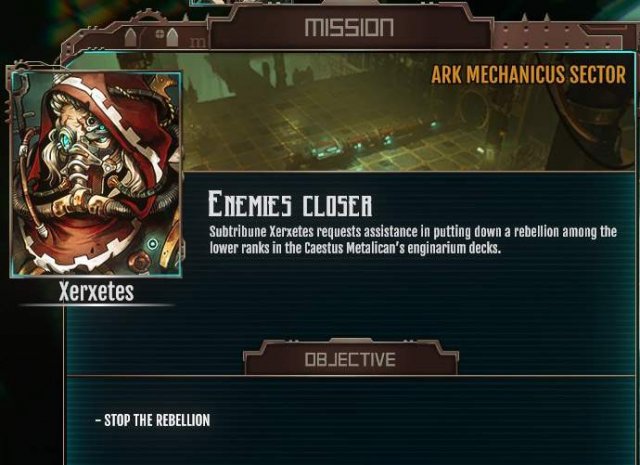
Enemies closer is the first mission of the series for Xerxetes. It's one of the more difficult missions in the game, so I've decided to write a guide for it. This is not a detailed walkthrough of the mission telling you what to do, but rather a guide that tells you about the options and approaches.
Rewards depend on a difficulty level (or are random per save?).
Mission begin with a dialog:
- Xerxetes: Your attention, Magos!
- Faustinius: My attention is on Silva Tenebris, Xerxetes. I must trust you to fulfill your duties as Subtribune without my oversight.
- Xerxetes: We cannot neglect the security on board the Caestus Metalican! I bring news of a violent uprising among the lower ranks of the Tech-Priests and menials on the enginarium decks.
- Faustinius: An uprising? This is the last thing we need. I permit myself to experience frustration at this news. Your solution, Subtribune?
- Xerxetes: There is but one solution to malcontents and rebellion, Magos! It is as the discipline of Physics states it: Force always wins!
Pre-Battle Hints
You will soak a lot of physical damage in melee range and acid damage over time. Take all physical armor items you can, they are more important than just buffing your health (though if you do have just base-10 health units - I would recommend skipping this mission until you are ready)
All major enemies (tech-priests) start being untargettable until they make their first attack, which will be really punishing. Additionally, they can gain 100% dodge chance against all attacks with a cooldown of 2 turns.
- Healing items are a must.
- You can disable the untargettability by triggering an opportunity attack (enter then exit melee range).
- Upgraded Servo-Skull and acid will still do damage, even if an enemy has 100% dodge chance.
- You always should know which tech-priest is on 100% dodge and which one has used his opportunity attack. Sadly you have to memorize it, as there's no display in the game itself.
If you have abilities with timeouts - try to use them as soon as sensible (just remember to manage cognition points). Also consider having at least 1 CP-free weapon for each of your Tech-Priests, as this will be a long and CP-expensive mission. Also I would advise using your servo-skulls primarily for collecting CP, even if you have 2 or 3 unused at the end of your turn.
Note that during the turn enemy can either move and shoot or "Sprint" for double the movement range, but no attack. If enemy enters your melee range after the sprint - you will still be locked into the opportunity shot. It can lead to the situations like this:
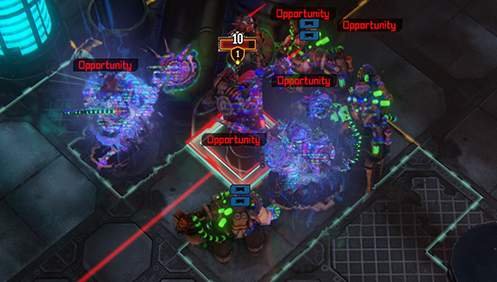
Choice 1: Objective
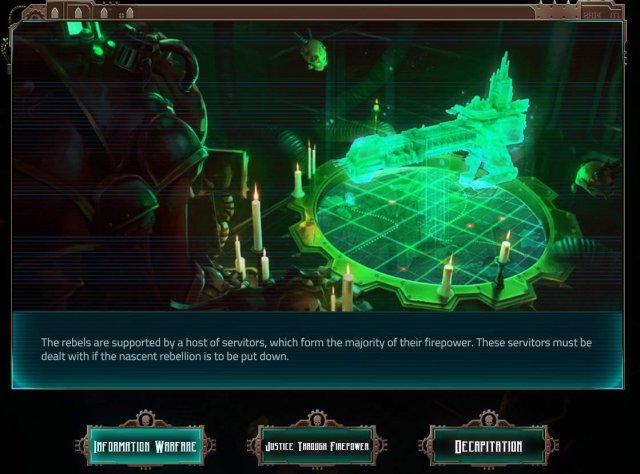
The first choice declares the mission objectives.
Options give respectively:
- Information warfare - Scan or destroy - objective is to scan OR destroy a console.
- Follow-up objective if any tech-priests are alive: Survive 3 rounds. .
- Justice through firepower - Survive 6 rounds - this can be done by kiting the enemies. Optimally take 2 tech-priests with movement buffs + 1 healing item each. After completing this mission 4 times I have found this objective to be the easiest one.
- Follow-up objective if any tech-priests are alive: None.
- Decapitation - Kill or destroy targets - you're supposed to destroy the leaders, however, there is no telltale which tech-priests are the leaders. Very likely you have to kill all but 2?
- Follow-up objective if any tech-priests are alive: Survive 3 rounds. .
Choice 2: Starting Positions
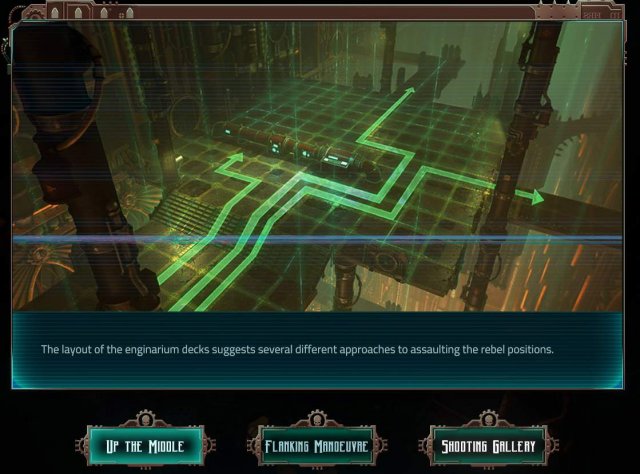
This allows you to pick the starting positions. Here are the screenshots of each one with a potential synergies to the objectives:
Up the Middle
Flanking Manoeuvae
Shooting Gallery
Choice 3: Chance to Strike a Blow
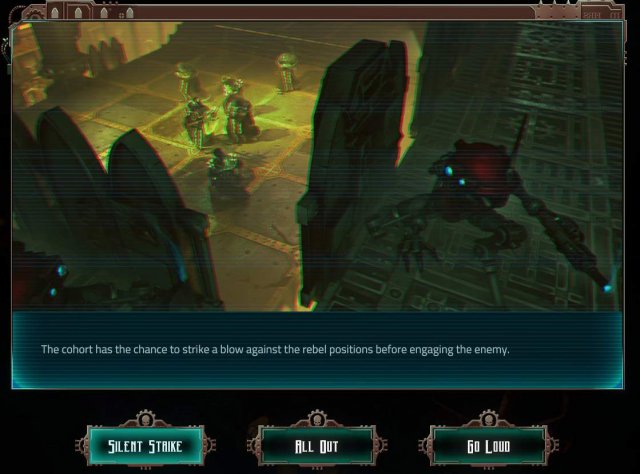
Silent Strike - Kill 1 Tech-Priest
- IMHO by far most beneficial one. tech-priests are by far the most challenging opponents. In the pure damage terms, it's equal up to 12 damage points excluding armor, but each priest can trigger a 1 turn of 100% dodge chance + they have both types of armor, making it realistically a significant relief.
- Worth it only if you can trigger Tech Priest's opportunity attack on the first move of the turn and kill him before he makes his action or if you have chosen Justice through firepower objective and want to spawn troopers that will go through a different lane than the one you've picked (I would recommend Skitarii Ranger Alpha, as he can avoid Opportunity attacks).
- It's equal up to 14 damage points (each servitor has 7 health excluding armor, servitors have 0-1 physical/energy armor, never both).
Enemies
Xenarite Tech-Priest
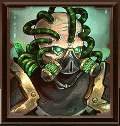
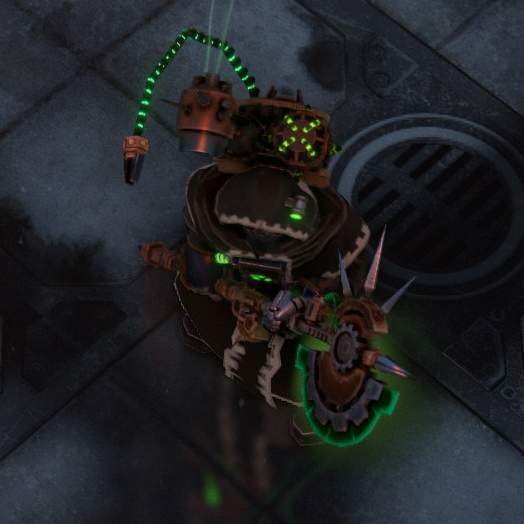
- Melee weapon (level 2 Xenarite Axe, adds 1 acid damage for 3 turns on top of a regular attack).
- Cog Occultaris (Untargetable until first attack of the match, +50% critical chance for the first attack).
- Omnispex 3 (Target enemy gains a 100% miss chance on attacks for 1 round, Cooldown 2).
- The spike'y thing (does direct damage at melee range).

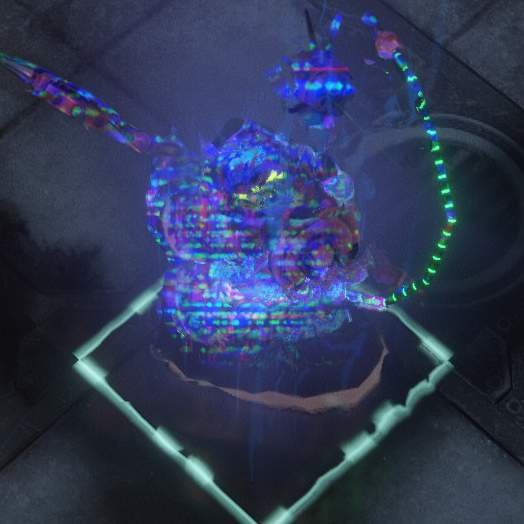
Impossible to target until the first attack
- First attack can be triggered either by letting enemy start his turn within his movement range or by triggering Opportunity attack (enter and exit melee range during your turn, or exit melee after enemy has sprinted within your melee range)
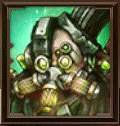
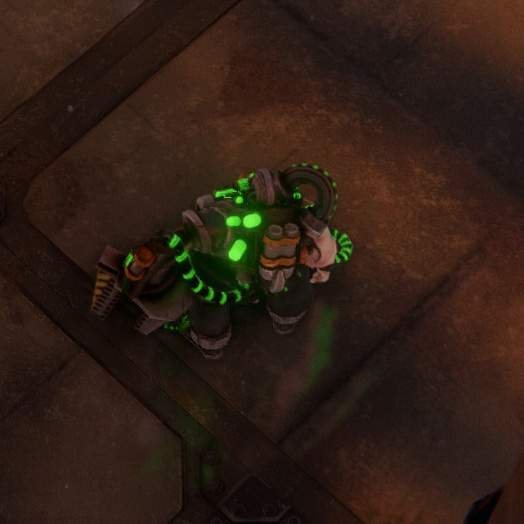
- Modified Servitor [lvl 3]. Energy or Physical Armor 0-3 (note that 3 armor servitors are very rare), Physical damage 1-3.
Below you can find a downscaled composite map of the mission. It's meant to be used only as a general overview, don't try to count individual squares of it, as it took many, many screenshots to build it and there are shifts of perspective as the camera moved over the battlefield. Sadly the game currently does not allow you to display the top-down perspective of the whole map at a glance.
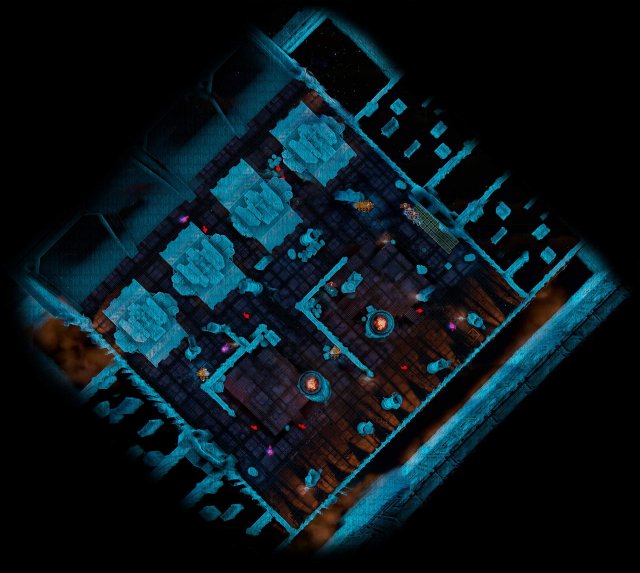
Mission Complete
This is the ending for the Justice through firepower objective:
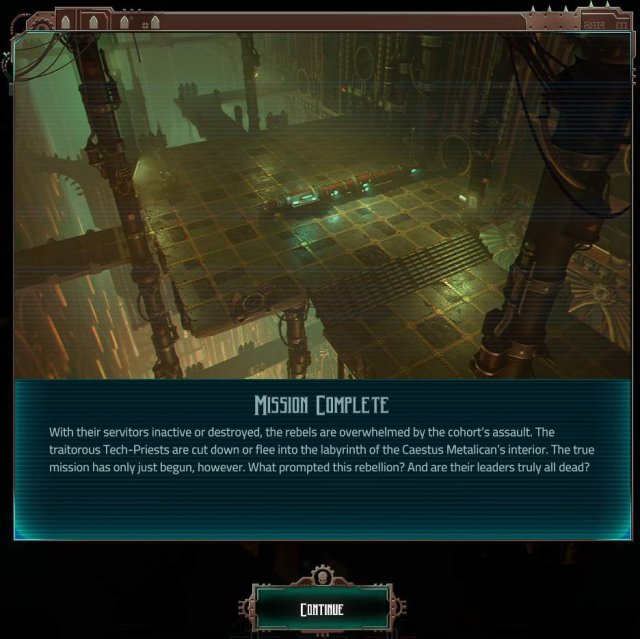
Mission Complete
With their servitors inactive or destroyed, the rebels are overwhelmed by the cohort's assault. The traitous Tech-Priests are cut down or flee into the labyrinth of the Caestus Metalican's interior. The true mission has only just begun, however. What prompted this rebellion? And are their leaders truly all dead?
Читайте также:

